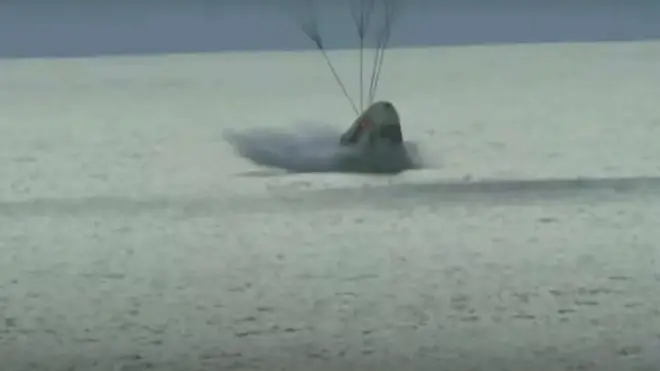
Shelagh Fogarty 1pm - 4pm
19 September 2021, 10:04

The SpaceX capsule carrying four space tourists landed in the Atlantic after three days in orbit.
Four space tourists ended their trailblazing trip to orbit on Saturday with a splashdown in the Atlantic off the Florida coast.
Their SpaceX capsule parachuted into the ocean just before sunset, not far from where their chartered flight began three days earlier.
The all-amateur crew was the first to circle the world without a professional astronaut.
The billionaire who paid undisclosed millions for the trip and his three guests wanted to show that ordinary people could blast into orbit by themselves, and SpaceX founder Elon Musk took them on as the company’s first rocket-riding tourists.
“Your mission has shown the world that space is for all of us,” SpaceX Mission Control radioed.
“It was a heck of a ride for us … just getting started,” replied trip sponsor Jared Isaacman, referring to more private flights on the horizon.
SpaceX’s fully automated Dragon capsule reached an unusually high altitude of 363 miles after Wednesday night’s lift-off. Surpassing the International Space Station by 100 miles, the passengers savoured views of Earth through a large bubble-shaped window added to the top of the capsule.

The four streaked back through the atmosphere early on Saturday evening, the first space travellers to end their flight in the Atlantic since Apollo 9 in 1969. SpaceX’s two previous crew splashdowns — carrying astronauts for NASA — were in the Gulf of Mexico.
This time, NASA was little more than an encouraging bystander, its only tie being the Kennedy Space Centre launch pad once used for the Apollo moonshots and shuttle crews, but now leased by SpaceX.
Mr Isaacman, 38, an entrepreneur and accomplished pilot, aimed to raise 200 million dollars (£145 million) for St Jude Children’s Research Hospital. Donating 100 million himself (£72.5 million), he held a lottery for one of the four seats. He also held a competition for clients of his Allentown, Pennsylvania payment-processing business, Shift4 Payments.
Joining him on the flight were Hayley Arceneaux, 29, a St Jude physician assistant who was treated at the Memphis, Tennessee hospital nearly two decades ago for bone cancer, and contest winners Chris Sembroski, 42, a data engineer in Everett, Washington, and Sian Proctor, 51, a community college educator, scientist and artist from Tempe, Arizona.

Strangers until March, they spent six months training and preparing for potential emergencies during the flight, dubbed Inspiration4. Their trip appeared to go well, leaving them time to chat with St Jude patients, conduct medical tests on themselves, ring the closing bell for the New York Stock Exchange, and complete some drawing and ukulele playing.
Ms Arceneaux, the youngest American in space and the first with a prosthesis, told her patients: “I was a little girl going through cancer treatment just like a lot of you, and if I can do this, you can do this.”
The four also took calls from Tom Cruise, interested in his own SpaceX flight to the space station for filming, and the rock band U2′s Bono.
Even their space menu was not typical: Cold pizza and sandwiches, but also pasta Bolognese and Mediterranean lamb.

Before beginning descent, Mr Sembroski was so calm that he was seen in the capsule watching the 1987 Mel Brooks’ film Spaceballs on his tablet.
Congratulations streamed in, including from the Association of Space Explorers to its four newest members.
Aside from trouble with a toilet fan and a bad temperature sensor in an engine, the flight went exceedingly well, officials said. Some of the four passengers experienced motion sickness when they reached orbit — just as some astronauts do.
“It was a very clean mission from start to finish,” said Benji Reed, a SpaceX senior director.
Nearly 600 people have reached space — a scorecard that began 60 years ago and is expected to soon skyrocket as space tourism heats up.